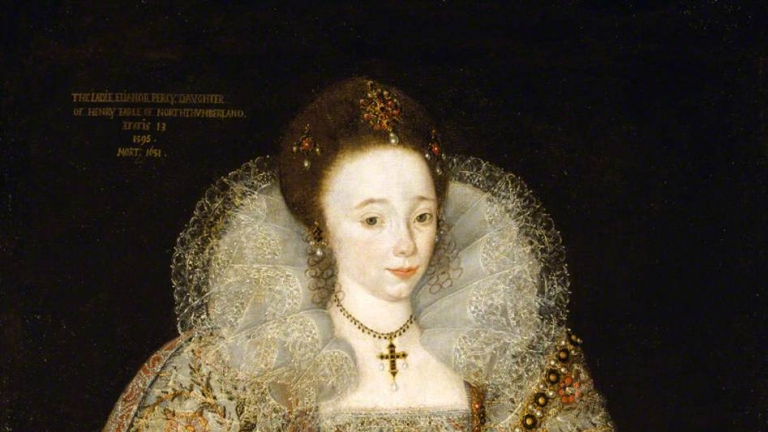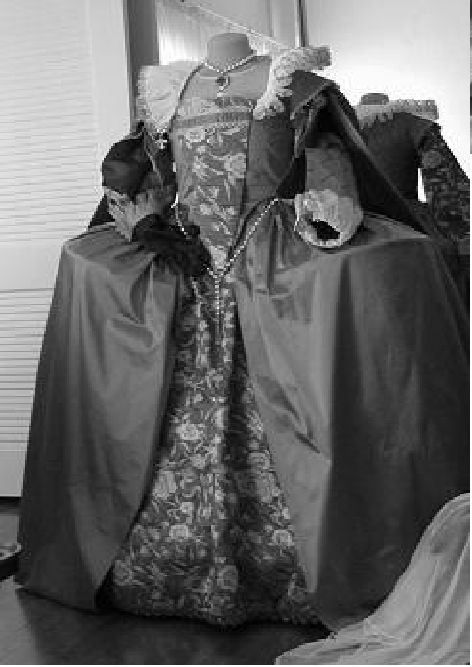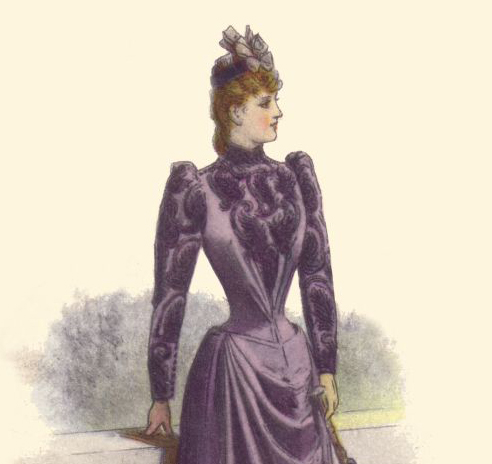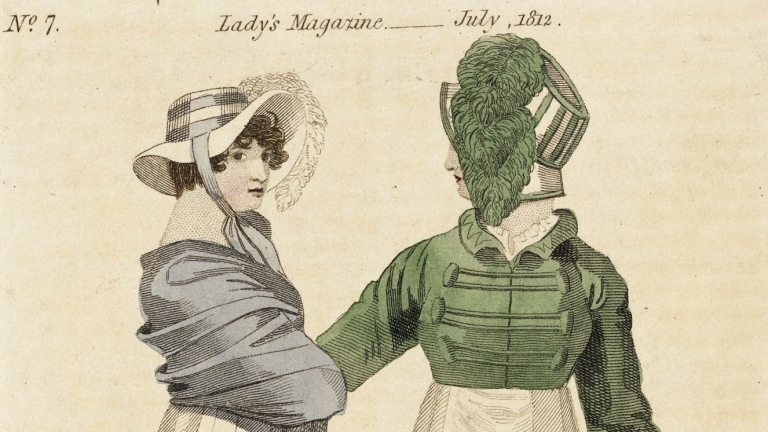Bits About Busks

by Cynthia Barnes, First published for the November/December 2012 issue of Finery
The busk of the 1580s and 1590s is not simply a piece of wood, but comprises the stay, covering case and the points which secure it. We thought it would be fun to recreate one as it might have looked in Queen Elizabeth I’s time. No original late 16th century busks exist. Nor can we find contemporary illustrations of them. What remains are descriptions, circumstantial archaeological evidence, opinionated contemporary writings and centuries of speculation. We’ve tried to remove as much of the latter as possible by going back to the original French and English sources and surrounding evidence as much as possible. The word “busk” remains in British English and Scots as a synonym for preparations or getting ready, just as “busque” or “busq” remains in French with similar meaning.
The 16th busk is made of “whalebone and wyre covered with sarceonet quilted” or of wood. Elizabeth I ordered several busks, materials unspecified, from her coffer-maker, Thomas Grene, a man who also made her wooden storage chests and traveling cases. As the Grene family worked in wood and iron, we can only make the obvious conclusion: the busk was made in the same materials. It may be that Grene made busks with ivory, precious metal inlay, or a carved face just as in the 18th century examples seen in museum collections. If so, surely these would have appeared in the Folger and Stowe inventories as jeweled or otherwise valuable items. They are remarkable in their absence.

As construction material for busks, Aphra Behn cites juniper in her poem “On a Juniper-Tree, Cut Down to Make Busks”. Thomas Platter mentions only “wood”. In just two warrants to the staff of her Great Wardrobe, Elizabeth ordered twenty busks. What did Queen Elizabeth need with so many busks? Gifts? Personal use? Surely they don’t wear out or become “lost from her Majesties Back” with such frequency that one should “stock up”. We can offer no sure answers.
In shape, the busk is described once as being “broad circular”. This could be describing rounding done in cross-section. It could also indicate rounding at the ends to make slipping the busk into place or into a case easier. The 17th century Louvre busk is 35.5 cm long. From extant paintings and corsets we can see that the 16th century bodice, and presumably the busk, was generally longer and probably sized to the wearer and her garment. The earliest extant wooden busk for which we have a picture is triangular, both in cross-section and in plan view. This is the model we chose to copy. Later, after this project was finished, we found a picture of a 17th century Norwich busk. It is rounded and carved on one face, flat on the other, with the top and bottom ends rounded.
The busk is inserted between corset and chemise, and secured with a busk-point (tie). We noted the pair of eyelet holes at the bottom of the von Neuberg corset. They’re poorly placed to secure a farthingale. The point through the eyelets may draw down the bodice, but none of the commentary or literary sources mention this. Nor are there corresponding holes in the von Neuberg bodice. The assumption, therefore, is that the single busk-point goes through eyelets on the lower CF of the corset. Sadly, in the two contemporary paintings of ladies at their toilets, we can neither affirm nor deny this pretty theory.
Corsets were quilted for comfort, or gently stiffened with whalebone. Only in the most extreme fashion circles are they stiffened by taffeta or “vellat”-covered wood. Busk covers for Queen Elizabeth were intended to match the garment for which they are particularly constructed. This may not be true for the rest of the nobility. The busk is removable and the corset can continue to be worn without the busk in place. Elizabeth ordered, at one sitting, four dozen “coveryngs” or “payer of cases”. We presume the cases are meant to either change with the dress, or that through wear & tear they need frequent replacement. Perhaps, they were minor gifts. In practice, the taffeta casing makes the busk easier to remove, though the sanded ash was not prone to snagging. In this implementation, “sarceonet” (silk taffeta) in shot “tawney” fabric was chosen to match the dress.

The points are proverbially necessary: “Ye look lyk a sow slacking a poynt” was a period insult. The points must be removed by being “cut, or else untie[d]”. We have chosen to secure the point to the busk casing as none of my extant busk pictures show through-holes unless, as in the pierced ivory example, they’re decorative. We could have made eyelets in the casing, but again, no evidence either way. We have chosen against eyelets as weak, possibly prone to thread wear or fabric tear. Instead, since this is a gown to dance a galliard in, the points are secured to the back of the busk using the strength of the silk taffeta point, not using the weak thread to hold busk to corset. The French dance master, Thoinot Arbeau, states “The Lavolta is a kind of galliard familiar to the people of Provence… you place your right hand below her busk to help her leap when you push her forward with your left thigh.” If a gent is to lift a lady via her busk, then it must be well anchored and made of pretty sturdy stuff.
The owner intends to apply a wax finish to seal the wood. There are large orders for wax in the Warrants but none for oil or other wood finishing products. I have no further documentation on this; it’s merely this woodworker’s knowledge of “how it’s done”.



Leave a comment